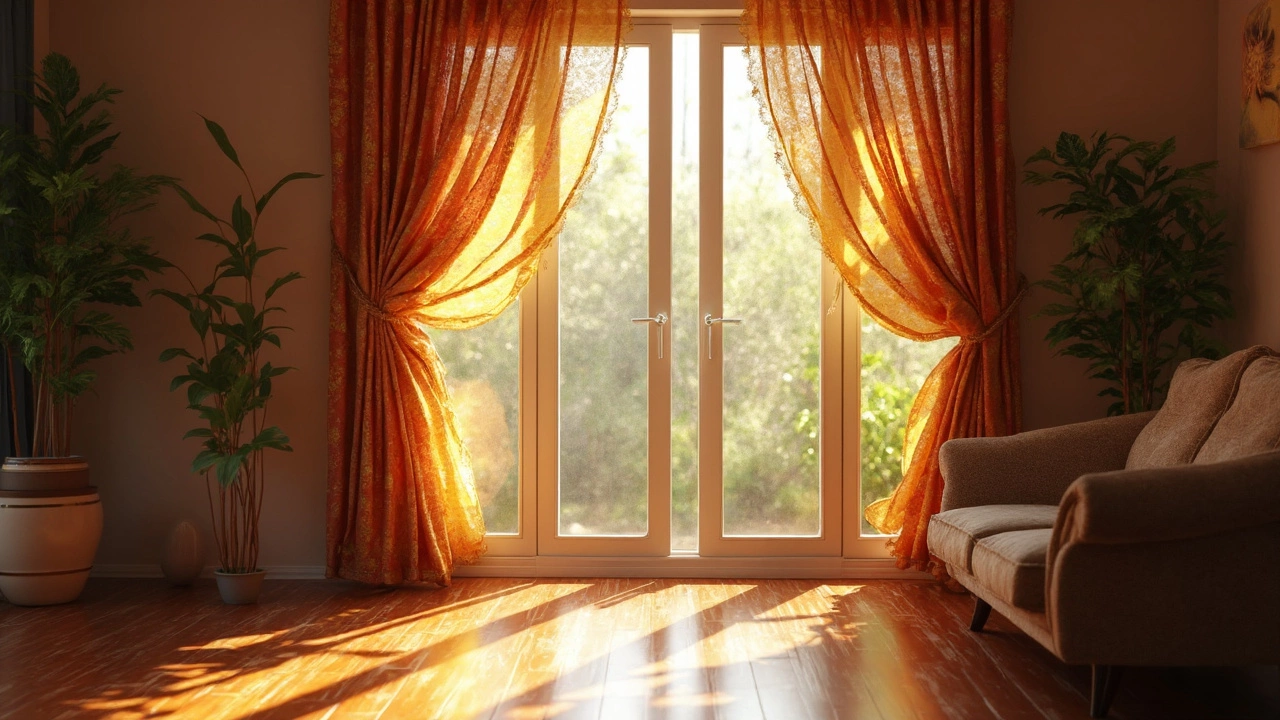What Curtains Keep the Heat Out Best?

So, you're tired of feeling like you're in a sauna every summer, right? We've all been there, trying to chill out without burning through cash on air conditioning. Well, the good news is, there’s a simple hack: curtains. Yup, the right kind of curtains can help keep heat out and make a difference.
First things first, you gotta know why curtains matter. They’re like the secret weapon on sun-baked days. Not only do they keep your room cooler, but they also save on energy costs. But, it’s not just any curtain that'll do the trick; you gotta pick the right type.
The most popular choice for blocking out heat is thermal curtains. They’re designed to reduce heat transfer, thanks to layers of insulation. Think of them like a comfy blanket – just for your windows. These bad boys keep your space at a cool and steady temp by reflecting sunlight and cutting down on heat gain.
- Why Heat Matters
- Types of Heat-Blocking Curtains
- Material Matters
- Color Choices
- Layering for Effectiveness
- Cost vs. Benefit
Why Heat Matters
Let’s break it down: when we talk about keeping heat out, we’re not just nagging about being sweaty and uncomfortable. The heat inside your home can really mess with your energy bills and your mood. Seriously, nobody wants to pay more for being less comfortable, right?
When the summer sun beats down on your house, heat seeps in through the walls, windows, and every little crevice. Your trusty AC has to work overtime to cool everything down, which means more energy consumption and higher bills.
And here’s the kicker: even if you’ve got top-of-the-line windows, they can still be a big source of heat. In fact, windows typically account for about 25-30% of residential heat gain, driving the mercury up and putting a sweat on your electricity meter.
There’s also the fact that high indoor temperatures can make people feel sluggish and cranky. When your home is comfortable, you’re more likely to enjoy your space and be productive. And honestly, who wouldn’t want that?
On top of feeling better, using thermal curtains or other heat-blocking curtains can be a solid move for the planet. By reducing the energy we use to cool our homes, we’re cutting back on our carbon footprint. So, when you keep heat out, you’re doing your pocketbook and the Earth a favor. That’s a win-win in my book.
Types of Heat-Blocking Curtains
Alright, let’s get into the nitty-gritty of heat-blocking curtains. Not all curtains do the trick when it comes to keeping your home cool, so you want to make sure you’re choosing the right ones.
The gold standard here is thermal curtains. They have special layers designed for insulation. Imagine them like a cozy winter jacket for your windows. They trap cool air inside during the summer while keeping the heat out. These layers usually include a foam core sandwiched between dense fabrics.
Then, you've got blackout curtains. These not only block light but also help in keeping the temperature stable. They’re great for bedrooms if you fancy a sleep-in without being nudged awake by the sun. Their thick fabric does wonders in shielding your room from outside heat.
Another option is reflective curtains or drapes. These come with a reflective backing, often made of aluminum, that bounces sunlight away. They’re like sunglasses for your windows, cutting glare while managing heat gain.
Finally, there are multiple-layer curtains that mix different materials. Combining a sheer with a thermal backing can give you style without sacrificing function. You can open the sheer for natural light and close the thermal when the heat’s too much to handle.
The key takeaway is to pick what suits your needs best. If heavy-duty heat blocking is what you want, go thermal. If aesthetics mixed with function is your thing, look into layered or reflective options.
Material Matters
Alright, let's dig into what really makes a difference: the material of your curtains. If you want to keep the heat where it belongs—outside—then knowing your curtain materials is key.
First off, thermal curtains get their mojo from layers. Unlike regular curtains, these have a core made from heavy, tightly woven fabric like polyester or cotton that’s sandwiched between layers. These layers help block sunlight and insulate your space. But not all materials are created equal.
Blackout curtains are another smart pick, especially if you value your noon naps. They’re not just about plunging your room into darkness; they’re crafted from thick materials that keep the outside temperature from creeping in. They typically have a foam or rubber backing that gives them that extra kick in thermal resistance.
Generally, heavier fabrics like velvet and suede do a better job at stopping heat transfer compared to lighter materials such as sheer or lace. You might also consider curtains with a white or reflective backing. Manufacturers often use this slick trick because they reflect sunlight back out the window, further cooling your space.
Here’s a quick comparison to illustrate:
| Material | Effectiveness |
|---|---|
| Polyester/Cotton (layered) | High |
| Blackout with foam backing | High |
| Velvet/Suede | Medium to High |
| Sheer/Lace | Low |
So picking the right material isn't just about style; it’s about functionality, especially in the heat of the summer. Choose wisely, and you could drop that unending battle with the thermostat.

Color Choices
Picking the right color for your curtains isn’t just about matching your couch or the latest Pinterest trend. Believe it or not, the color of your curtains can actually impact how much heat they keep out. Wild, right?
Darker colors tend to absorb more heat. Picture a black t-shirt on a sunny day – toastier than a marshmallow at a campfire. So, if you’re aiming to keep things cool, you might want to steer clear of darker hues.
Instead, light-colored curtains are your best friend. Shades like whites, light grays, or soft pastels reflect more sunlight rather than sucking it in. That way, less heat comes inside, keeping your living room from turning into a desert.
Ever try adding a layer of sheer curtains behind your main ones? It's a neat trick! This setup lets you enjoy some natural light while the sheers act as a buffer, reflecting sunlight. Plus, it adds a nice depth to your room's vibe.
Some folks swear by metallic-colored curtains. These have a bit of a reflective surface, bouncing sunlight off like a super shield. But, be sure they fit your style; otherwise, you might end up with a space that feels more spaceship than homey.
Remember, it’s not just about picking any light color. Opt for those with a UV-resistant finish. This little tweak can boost their effectiveness in blocking heat, helping you double down on both style and function.
So, next time you’re curtain shopping, think of them not just as window decor but as partners in your energy-saving quest. Ready to choose some colors now?
Layering for Effectiveness
Alright, let's talk layers—no, not cake, but curtains. Layering your window dressings might just be your secret weapon against the heat. Think of it like layering clothes; you get more coverage, which in this case means better protection against the sun.
One popular strategy is to combine thermal curtains with other types. Start with a sheer curtain, which provides a bit of privacy and diffuses light. On top of that, add blackout curtains that are lined with thermal material. This double whammy not only blocks light but also significantly reduces heat.
Here's a simple breakdown of how to do it:
- Mount a double curtain rod.
- Hang sheer curtains on the rod closest to the window.
- Add blackout thermal curtains on the outer rod.
The sheer layer lets in some diffused light, creating a comfortable glow during the day, while the blackout layer comes into play when you need serious sun blocking.
Don't think it's just theory—studies show that properly layered curtains can reduce heat gain by up to 33%. Check this out:
| Layer Type | Heat Reduction |
|---|---|
| Single Layer | 10-15% |
| Double Layer | 25-33% |
And if you're feeling fancy, consider adding a cornice or a pelmet at the top, which helps stop warm air from creeping in around the edges.
Layering might sound like a bit of extra effort, but you'll make up for it with cooler rooms and potentially smaller energy bills. So, next time you're battling the summer sun, remember: it's all about those layers.
Cost vs. Benefit
Alright, let's talk dollars and sense – see what I did there? Investing in the right curtains to keep heat out isn't just about comfort; it's also a smart financial move. You might be thinking, "Do I really need this?" Well, if slashing your energy bills sounds good, then yeah, you do.
Spending a bit upfront on thermal curtains can save you in the long run. We’re talking about reducing the need to max out your air conditioner. Less AC means lower energy bills. A quality pair of curtains can cut back heat loss through windows by up to 25%, which is pretty impressive.
Now, how much will you shell out for these energy-saving wonders? A decent set of thermal curtains can range from $20 to $150 per panel, depending on size, brand, and material. Sure, the ones with more layers or specialized fabrics might be on the pricier side, but they tend to last longer and work better, so they’re worth every penny.
Think about this: during a hot summer month, if thermal curtains can help reduce your cooling cost by even 10%, that’s real savings right there. Say your AC bill is $200 a month. A 10% cut means you save $20, and those savings add up over time.
In essence, you're investing in your comfort and also in a more energy-efficient home. And you’re doing your bit for the planet, too. So, weighing the upfront cost against the longer-term benefits, it’s pretty clear that grabbing some heat-blocking thermal curtains is a solid move.